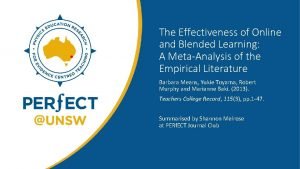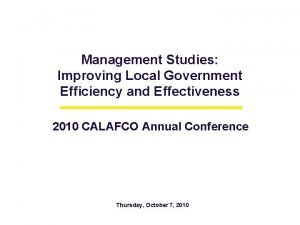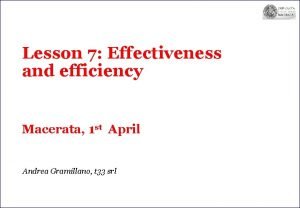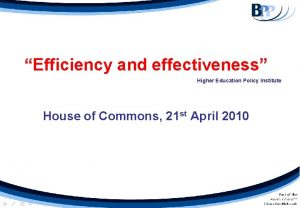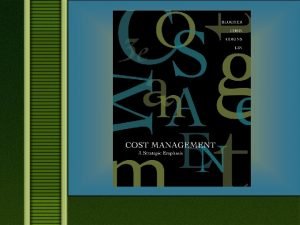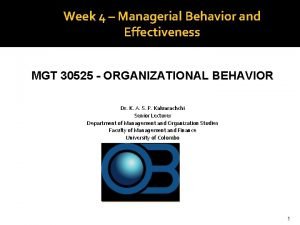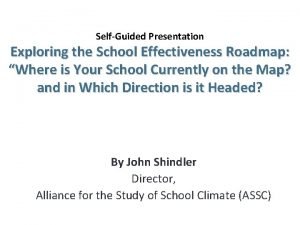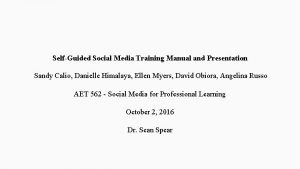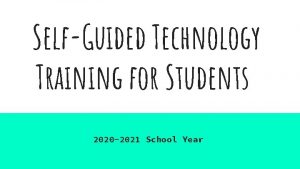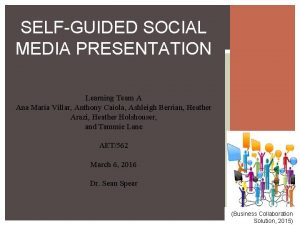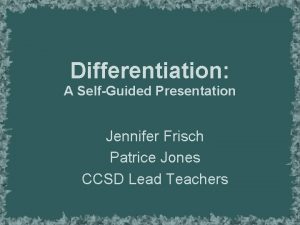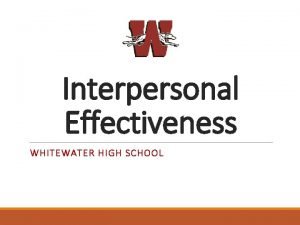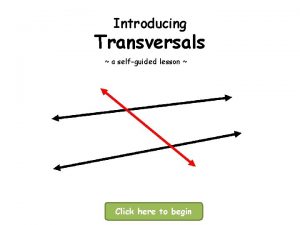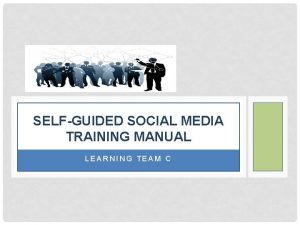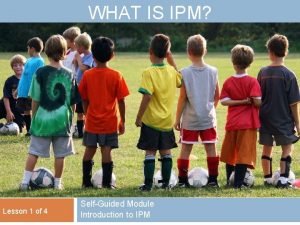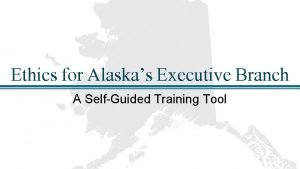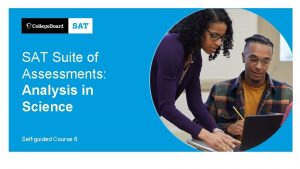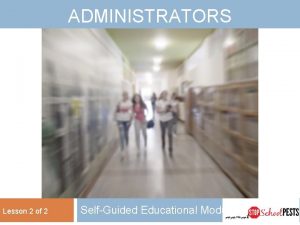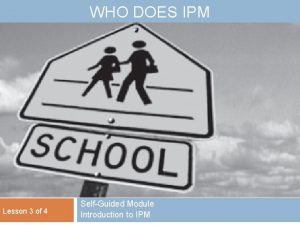SelfGuided Presentation Exploring the School Effectiveness Roadmap and



























- Slides: 27

Self-Guided Presentation Exploring the School Effectiveness Roadmap and the Design and Data of the ASSC School Climate Assessment Instrument (SCAI) By John Shindler Director, Alliance for the Study of School Climate (ASSC)

In This Presentation This Power. Point presentation will assist you in better understanding the design features and usage of the Alliance for the Study of School Climate (ASSC) School Climate Assessment Instrument (SCAI). Included in the presentation will be the following: • Explanation of the unique nature of the SCAI survey instruments • A brief explanation of why the SCAI obtains high levels of reliability, and high correlations with other variables such as student achievement and is therefore the most predictive. • A step-by-step construction and explanation of the ASSC roadmap and the growth pathway that it implies.

The Big Picture – School Effectiveness Roadmap What is occurring in any school can be depicted on a practical and theoretical “roadmap” of phenomenon. And every location on the roadmap implies a whole series of explainable and predictable characteristics. “Where is your school located? ” and “Do you know where you are headed? ” Functional and Effectiveness Trust and Empowerment Fear and Control Dysfunction and Ineffectiveness

School Climate Score (SCAI) by Student Achievement (CA API) School Climate Rating Student Achievement Scores When ASSC SCAI School Climate ratings at any school are correlated with the student achievement scores at that school, we find a very strong relationship. As you can see in the scatter plot figure from one data set, when the climate is high, the achievement is high, and when the climate is low the achievement is also low. This degree of correlation (+0. 7) is only obtained with the SCAI.

A Complete Picture of the School Climate: The Eight Dimensions used in the ASSC SCAI The ASSC SCAI assumes school climate to mean the “essential phenomenon” at the school. So SCAI content includes items related to values, practices, and symptoms of problems, as well as the root causes of potential problems. Both causes and effects are measured in each of the following eight ASSC school climate dimensions listed below – which are intended to capture the whole of a school’s climate. 1. 2. 3. 4. 5. 6. 7. 8. Physical Appearance Faculty Relations Student Interactions Leadership and Decision-Making Discipline Environment Learning and Assessment Attitude and Culture Community Relations

Sample Item from the ASSC SCAI-S-G Reflecting the Unique Structure of the ASSC SCAI From scale 5 re: Discipline High (level 3) Middle (level 2) Low (Level 1) Maximum use of Student Generated Ideas Occasional use of student generated ideas Teachers make the rules --------------5 -----4 ------3 -----2 -----1 -----One of the most significant differences between the SCAI surveys and other climate surveys is that the SCAI uses an analytic trait scale format vs. a Likert scale format. The result is 1) much more accurate/precise ratings, 2) higher levels of reliability among participants, and 3) more usable data once it is collected (e. g. , since the cure is implied in the diagnosis).

SCAI Ratings imply Levels of Phenomenon In the next slide, the table represents three levels of school phenomenon. What we find is that the various phenomenon at any particular school tends to reflect a particular level – everything at the school tends to be aligned with either low, middle or high level principles and qualities. What this finding shows is that both a school’s practices and outcomes tend to reflect its guiding values, references and principles. More about this later.

ASSC SCAI School Climate Levels Level 3 Level 2 Level 1 System Intentional Semi-intentional Ethos Sound vision translated into effective practice Good intentions Practices defined by translated into the relative selfpractices that “work. ” interest of faculty and staff System/Principle Program Level of Perception (LOP) Effect on Students Accidental Sensory Staff relations Liberating Perpetuating Experience changes Experience has a students for the better mixed effect on students Collaborative Congenial Domesticating Experience has a net negative effect on students Competitive Psychological Outcome Promotes a Mixed Psychology of Success Psychology Achievement High Promotes a Psychology of Failure Low Middle

The Core of a Sound and Healthy School Climate: A Psychology of Success (POS) Psychology of Failure (POF) Internal Locus of Control External Locus of Control Belonging & Acceptance Alienation and Worthlessness Growth-Orientation Fixed-Ability Orientation A “psychology of success” (POS) can be defined by the three well researched factors listed above. Each factor contributes strongly to student achievement and social and emotional well-being. A successful school (i. e. , 3 level) has a POS that pervades every aspect of what it does. Consequently a POS and its three sub-factors are imbedded into each SCAI item. As a result, the SCAI ratings are able to represent the degree to which more POS or POF is guiding the actions and experiences of the members of the school community. Each sub-factor is defined briefly on the next slide.

Psychology of Success (POS) �INTERNAL vs. EXTERNAL LOCUS OF CONTROL (LOC): This factor is defined by one’s sense of internal causality and orientation toward personal responsibility. The more internal our LOC, the more we feel that our destiny is in our own hands. �SENSE OF BELONGING AND ACCEPTANCE vs. ALIENATION: This factor reflects how much one feels wanted and a part of the group, and how much one likes and accepts themselves as they are. The more one feels accepted and acceptable, the more they are able to express themselves, act authentically, and be fully present to others. �GROWTH-ORIENTATION vs. FIXED-ABILITY ORIENTATION: This factor relates to one’s thinking related to the root of their competence (Dweck, 2007). A growthorientation approaches tasks with the question “How can I learn and grow from the process of doing this? ” whereas the fixed-ability orientation asks “What will the outcome say about my innate ability in this area? ” Explained in detail in the book Transformative Classroom Management

Building the School Effectiveness “Roadmap” Another unique feature of the ASSC SCAI is that all school ratings can be placed onto an effectiveness “roadmap” that provides context to the ratings. One’s location on the roadmap will imply both what they are doing currently as well as what they would want to do to move “up the roadmap/pathway. ” What we assume at ASSC is that the primary goals of the survey process are to learn 1) where one is on the roadmap and then 2) what it would take to move up the roadmap’s pathway to higher levels of function and effectiveness. The roadmap is comprised of the following topographical layers: • Teaching Style (or School Paradigm) Matrix • Levels of Perception • School Phenomenon levels including POS/POF • School Climate and Student Achievement Correlation Data

Roadmap Base: Teaching Style Matrix The next slide depicts the “teaching style matrix” – which acts as the base of the ASSC roadmap. The vertical axis of the matrix represents the level of function and effectiveness in the classroom. The horizontal axis reflects whether the teacher is using values and practices based more on either trust and empowerment (student-centered) or control and manipulation (teacher-centered). The result is one of four potential teaching styles/orientations. Each teaching orientation (Style-1, 2, 3 or 4) will produce very different results as far as classroom climate and function.

Teaching Style Matrix – Orientation by Function Level High Function/Intentional Internal Locus of Control Student-Centered/Empowering Teacher-Centered/Controlling 1 -Style Functional/Student-Centered Facilitator/Leader Self-Directed Students “Our Class” 2 -Style Functional/Teacher-Centered Conductor /Manager Well Trained Students “My Class” 3 -Style Dysfunctional/Student-Centered Enabler/Passive Self-Centered/Chaos “The Students” 4 -Style Dysfunctional/Teacher-Centered Authoritarian/Hostile Dominance/Obedience or Rebellion “Those Students” Low Function/Accidental External Locus of Control

Translating the Matrix Logic to the School Level A similar matrix can be created to represent what is happening generally in a school. Just as we can identify the style (i. e. , 1, 2, 3 or 4) that a teacher is using in a classroom, we can use essentially the same axes to assess the intentions and practices at the school-wide level. The horizontal axis represents the level of function and the vertical axis represents the continuum from empowering to controlling. The result is the four quadrant “school orientation” matrix, depicted in the next slide.

School-Wide Orientation Matrix Empowerment Connection Trust High Function 1 -Paradigm School - Empowering Vision-Driven Facilitative Intentional Leadership Student-Centered Classrooms Community Climate Mostly 1 -style teaching Low Function 3 -Paradigm School - Amorphous Enabling Passive Leadership Accidental Unstructured learning Leadership Control Comparison Fear 2 -Paradigm School - Managed Efficiency-Driven Top-Down Leadership Teacher-Centered Classrooms Institutional Climate Mostly 2 -style teaching 4 -Paradigm School -Bossy Dominating and Self-serving Leadership Insecure Climate Lecture and Test Teaching Lots of 3 -style teaching (but also Domesticating Climate a random combo of others) Mostly 4 -style teaching

Overlaying Level by Style We can locate three “levels of school” onto the teaching style matrix and/or the school orientation matrix at the approximate theoretical points shown on the next slide.

Teaching Style Matrix – Adding the School Levels High Function/Intentional Internal Locus of Control Student-Centered/Empowering Teacher-Centered/Controlling 1 -Style Level 3 Functional/Student-Centered Facilitator/Leader Self-Directed Students “Our Class” 2 -Style Functional/Teacher-Centered Conductor /Manager Well Trained Students Level 2“My Class” 3 -Style 4 -Style Dysfunctional/Student-Centered Dysfunctional/Teacher-Centered Enabler/Passive Authoritarian/Hostile Level 1 Self-Centered/Chaos Dominance/Obedience or Rebellion “The Students” “Those Students” Low Function/Accidental External Locus of Control

Roadmap Elevation: Levels of Perception The next slide outlines a concept that helps an individual or collective reflect upon what level of processing they may be using at any point in time. These levels are termed the “levels of perception” (from Perceptual Control Theory). There are four fundamental levels beginning at the bottom with a basic survival or “sensory” mode. The next higher level is defined by routines and practical action - termed the “program” level. This is the level at which most schools tend to place most of their focus. Above that level, persons and entities use more “principle” driven thinking to guide their actions. Finally, the highest level is defined by an integrated or “systems” orientation. Our research shows that the more often that those at a school uses the higher levels of perception to inform their action the more intentional and therefore the more effective and functional the school will be.

Levels of Perception (re: PCT) Abstract General Internal Being System Concept Beliefs Social Contract Principles Everyday Activities Program - Rules/consequences Tests, bells Or Knowledge Concrete Specific External Doing Sensory The way we take in the world

Applying the Correlation to the Roadmap To complete the roadmap, we can apply the climate – achievement correlation data onto the matrix, as shown in the next slide. The correlation of +0. 7 can be seen best in the scatter plot display of a set of school data comparing SCAI and student achievement. This 0. 7 correlation has held up as we have collected data from hundreds of schools. As show in the next slide, as schools move up the roadmap both their climate ratings and their achievement move together – creating a “pathway” up the roadmap.

SCAI School Climate Ratings, and Corresponding Predicted Student Achievement Score Correlations by Teaching Practice High Function/Intentional Internal Locus of Control Student-Centered/Empowering 4. 8 SCAI @900 1 -Style Teacher-Centered/Controlling 4. 5 SCAI @800+ System 4 SCAI @800 2 -Style Principle 3. 5 SCAI @750 3 SCAI @650 Program 2. 5 SCAI @550 2 SCAI @450 1. 7 SCAI @400 3 -Style 1. 5 SCAI @350 1. 0 @250 Sensory Low Function/Accidental External Locus of Control 4 -Style

Putting it All Together When we combine all factors discussed earlier, the result is a very predictive and reliable roadmap for understanding school effectiveness (shown in the next slide). To build this roadmap, and the growth pathway that it implies, we have used the school or classroom matrix as the base, embedded the levels of perception, located the school performance levels, and then placed quantitative correlational data onto the map into its theoretical locations. The resulting roadmap provides both a theoretical understanding of what is happening at a school, as well as what is intended, and shows why intention, practice and results are so interdependent. So practically, if we know one of three things - 1. SCAI ratings, 2. student achievement scores, or 3. common practices – we can infer the other two with great certainty.

The Complete Roadmap and Common Pathway on which Schools are Typically Located High Function/Intentional Internal Locus of Control Student-Centered/Empowering 4. 8 SCAI @900 1 -Style 4. 5 SCAI @800+ System 3 4 SCAI @800 Teacher-Centered/Controlling Principle 3. 5 SCAI @750 1. 7 SCAI @400 3 -Style 2 -Style 1. 5 SCAI @350 1. 0 @250 2 1 3 SCAI @650 Program 2. 5 SCAI @550 2 SCAI @450 Sensory Low Function/Accidental External Locus of Control 4 -Style

Why is the Roadmap Pathway Shaped as it is? Why does the ASSC school effectiveness roadmap growth pathway have a curve shape and not some other form? • • The pathway represents where most schools fall on the roadmap as well as the typical developmental path/trajectory that schools take as they move up from lower to higher. Schools representing the lowest levels of function will be located at a broad range of points at the bottom of the map. Low performing schools can be low performing for a variety of reasons and appear in a variety of forms - they can be somewhat autocratic or permissive or in between. So the pathway starts with a wide base at the bottom of the roadmap and few assumptions. As schools become more functional, they tend to move from more survival thinking to more programmatic thinking, as a result, typically becoming more teacher-centered, and standardized (i. e. , moving toward a 2 -Paradigm). The primary interest at this location tends to be defined by managing things. However, to move to the highest levels on the roadmap, a school must make a turn toward more empowering practices and climate. This requires more vision and shared values for encouraging teacher and student potential. Thus the growth/improvement pathway curves toward that location in the roadmap.

Final Thoughts about the Roadmap In our experience, we have yet to find a school, out of the hundreds that we have assessed or observed, whose function and performance level did not fit onto a location on the roadmap. The reason is that, given the nature of the forces that govern the phenomenon of schools, intentions, practices and outcomes tend to be highly inter-related. Schools at the high levels of the roadmap are doing and trying to do very different things than those at the middle or lower levels. We would like to challenge all schools to reflect on the following questions – “where are you going? ” and “what are you using to guide your journey? ” And we could also ask, “Where are you now? Do you know? ” We hope that providing you an accurate sense of where you are currently and a roadmap for moving toward your desired future goal will be helpful to your efforts.

Presenter Contact Information John Shindler, Ph. D jshindl@calstatela. edu Charter College of Education California State University, Los Angeles Alliance for the Study of School Climate (ASSC) www. calstatela. edu/schoolclimate (or just Google “School Climate”) Transformative Classroom Management www. transformativeclassroom. com (or just Google “Classroom Management Resources”) Upcoming Book: The Transformative Leader’s Roadmap to Facilitating School Excellence and Progress Up the Growth Pathway

Correlation Table Achievement by Climate Factors SCAI - Overall API School Climate Scale 5 Discipline and Management SCAI – Overall School Climate --- +0. 7 API Achievement Performance Index +0. 7 ---- +0. 7 SCAI Scale 5 Discipline and Management +0. 9 +0. 7 ---- +0. 9
 Future of linux
Future of linux Brow presentation birth
Brow presentation birth Vertex presentation
Vertex presentation The effectiveness of online and blended learning
The effectiveness of online and blended learning It is arrangement of people in an organization
It is arrangement of people in an organization Efficiency and effectiveness examples
Efficiency and effectiveness examples Efficiency and effectiveness examples
Efficiency and effectiveness examples Efficiency and effectiveness in higher education
Efficiency and effectiveness in higher education Managing productivity and marketing effectiveness
Managing productivity and marketing effectiveness Managerial behavior and effectiveness
Managerial behavior and effectiveness Hình ảnh bộ gõ cơ thể búng tay
Hình ảnh bộ gõ cơ thể búng tay Bổ thể
Bổ thể Tỉ lệ cơ thể trẻ em
Tỉ lệ cơ thể trẻ em Chó sói
Chó sói Glasgow thang điểm
Glasgow thang điểm Bài hát chúa yêu trần thế alleluia
Bài hát chúa yêu trần thế alleluia Kể tên các môn thể thao
Kể tên các môn thể thao Thế nào là hệ số cao nhất
Thế nào là hệ số cao nhất Các châu lục và đại dương trên thế giới
Các châu lục và đại dương trên thế giới Công thức tính thế năng
Công thức tính thế năng Trời xanh đây là của chúng ta thể thơ
Trời xanh đây là của chúng ta thể thơ Mật thư tọa độ 5x5
Mật thư tọa độ 5x5 101012 bằng
101012 bằng Phản ứng thế ankan
Phản ứng thế ankan Các châu lục và đại dương trên thế giới
Các châu lục và đại dương trên thế giới Thơ thất ngôn tứ tuyệt đường luật
Thơ thất ngôn tứ tuyệt đường luật Quá trình desamine hóa có thể tạo ra
Quá trình desamine hóa có thể tạo ra



